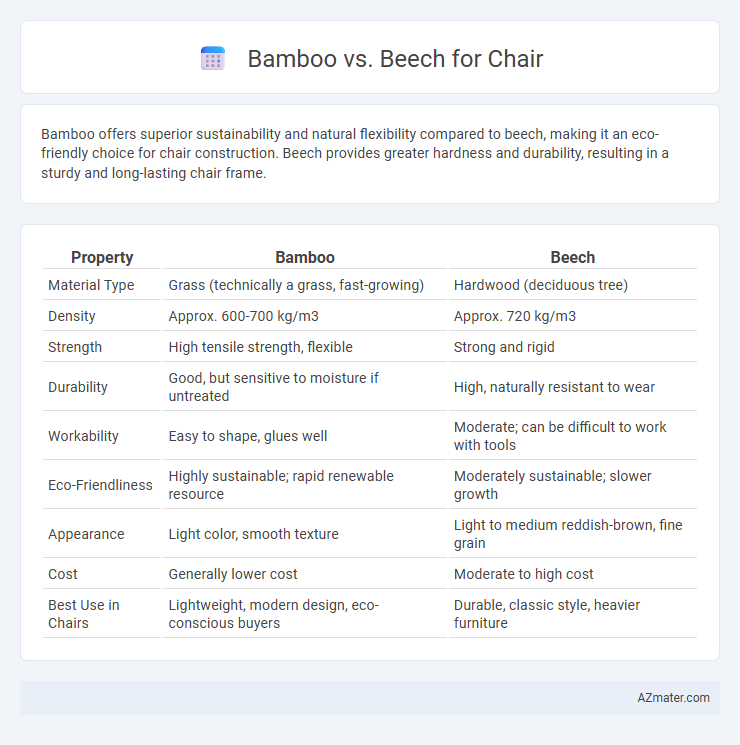Bamboo offers superior sustainability and natural flexibility compared to beech, making it an eco-friendly choice for chair construction. Beech provides greater hardness and durability, resulting in a sturdy and long-lasting chair frame.
Table of Comparison
| Property | Bamboo | Beech |
|---|---|---|
| Material Type | Grass (technically a grass, fast-growing) | Hardwood (deciduous tree) |
| Density | Approx. 600-700 kg/m3 | Approx. 720 kg/m3 |
| Strength | High tensile strength, flexible | Strong and rigid |
| Durability | Good, but sensitive to moisture if untreated | High, naturally resistant to wear |
| Workability | Easy to shape, glues well | Moderate; can be difficult to work with tools |
| Eco-Friendliness | Highly sustainable; rapid renewable resource | Moderately sustainable; slower growth |
| Appearance | Light color, smooth texture | Light to medium reddish-brown, fine grain |
| Cost | Generally lower cost | Moderate to high cost |
| Best Use in Chairs | Lightweight, modern design, eco-conscious buyers | Durable, classic style, heavier furniture |
Introduction: Bamboo vs Beech Chairs
Bamboo chairs offer lightweight durability and natural resistance to moisture and pests, making them ideal for both indoor and outdoor use. Beech chairs provide a solid, sturdy frame with a smooth grain that accepts stains and finishes well, ensuring a classic and elegant appearance. Choosing between bamboo and beech depends on factors like desired aesthetics, environmental impact, and specific use conditions.
Material Composition and Sources
Bamboo, composed primarily of cellulose fibers embedded in a lignin matrix, offers exceptional tensile strength and natural flexibility, making it a sustainable alternative to traditional hardwoods. Beech wood, derived from the Fagus genus, features a dense, fine-grained structure rich in cellulose and hemicellulose, providing durability and a smooth finish ideal for chair manufacturing. Bamboo is predominantly sourced from fast-growing tropical regions in Asia, while beech is native to and harvested mainly in European and North American temperate forests, impacting availability and environmental footprint.
Sustainability and Environmental Impact
Bamboo is a rapidly renewable resource, growing up to 3 feet per day, which makes it highly sustainable compared to beech trees that take decades to mature. Bamboo cultivation requires fewer pesticides and less water, resulting in a lower environmental impact, while beech forests, often harvested intensively, can contribute to deforestation and habitat loss if not managed responsibly. Choosing bamboo for chair production supports carbon sequestration and reduces deforestation, making it an eco-friendlier option than traditional hardwoods like beech.
Strength and Durability Comparison
Bamboo offers exceptional tensile strength, often surpassing traditional hardwoods, making it highly durable for chair construction with resistance to cracking and warping. Beech wood provides strong density and hardness, delivering excellent impact resistance but may be more prone to moisture-related damage over time. Bamboo's natural flexibility and rapid growth cycle contribute to sustainable durability, while beech requires careful maintenance to preserve its structural integrity.
Aesthetic Appeal and Texture
Bamboo chairs offer a sleek, natural aesthetic with a smooth, glossy texture that highlights their light, warm tones, making them ideal for modern and eco-friendly interiors. Beech chairs feature a more traditional, matte finish with a fine, tight grain that provides a subtle elegance and a soft, smooth texture. Both woods bring distinct tactile experiences and visual charm, with bamboo emphasizing contemporary appeal and beech showcasing classic warmth.
Weight and Handling Differences
Bamboo chairs are significantly lighter than beech chairs, with bamboo weighing approximately 30-50% less, making them easier to move and handle. Beech, known for its dense and sturdy structure, provides greater stability but results in heavier furniture that can be more cumbersome to transport. The lightweight nature of bamboo enhances portability without compromising strength, while beech chairs offer a more solid, traditional feel ideal for stationary use.
Cost and Affordability
Bamboo chairs are generally more affordable than beech chairs due to bamboo's rapid growth and sustainable harvesting, reducing material costs. Beech wood, known for its durability and fine grain, typically commands a higher price because of slower growth rates and more intensive processing. Budget-conscious buyers often prefer bamboo for cost-effective, eco-friendly seating options without sacrificing strength.
Maintenance and Longevity
Bamboo chairs require minimal maintenance due to their natural resistance to moisture and pests, making them ideal for humid environments. Beech wood, while durable and strong, demands regular polishing and protection from excessive moisture to prevent warping and cracking. Bamboo typically offers superior longevity in outdoor or variable conditions, whereas beech is better suited for indoor use with controlled environments.
Best Use Cases for Each Wood
Bamboo is ideal for outdoor chairs and modern, eco-friendly furniture due to its lightweight durability, rapid renewability, and resistance to moisture and insects. Beech excels in indoor seating, especially in traditional or classic-style chairs, because of its hardness, fine grain, and smooth finish, which allows for precise carving and staining. Bamboo suits high-traffic or casual environments, while beech is preferred for formal settings requiring durability and aesthetic refinement.
Final Verdict: Which is Better for Chairs?
Bamboo offers superior sustainability and strength, making it an eco-friendly choice for chair construction with natural resistance to moisture and warping. Beech wood provides excellent durability and a smooth finish, ideal for traditional chair designs requiring long-lasting performance and a classic appearance. Ultimately, bamboo excels in environmental benefits and resilience, while beech is preferred for refined aesthetics and consistent hardness in chair manufacturing.

Infographic: Bamboo vs Beech for Chair
 azmater.com
azmater.com